Jainism traditionally known as Jain Dharma, is an ancient Indian religion and a method of acquiring perfect knowledge of self and universe and perfect joy through extrasensory means as sensory means are inadequate to acquire them. The method is summarized in its religious text Pravachanasara and published by Cambridge University Press in 1934. It is further elaborated in Samayasara and Tattvartha Sutra from parallelist and interactive lenses respectively. Jain dharma traces its spiritual ideas and history through a succession of twenty-four leaders or Tirthankaras, with the first in current time cycle being Lord Rishabhanatha, whom the tradition holds to have lived millions of years ago, the twenty-third tirthankara Lord Parshvanatha whom historians date to 8th century BCE, and the 24th tirthankara, Lord Mahavira around 600 BCE. Jainism is considered to be an eternal dharma(Sanatana Dharma) with the tirthankaras guiding every time cycle of the cosmology.
The main religious premises of the Jain dharma are ahimsa (non-violence), anekantavada (many-sidedness), aparigraha (non-attachment) and asceticism (abstinence from sensual pleasures). Devout Jains take five main vows: ahimsa (non-violence), satya (truth), asteya (not stealing), brahmacharya (sexual continence), and aparigraha (non-possessiveness). These principles have affected Jain culture in many ways, such as leading to a predominantly vegetarian lifestyle. Parasparopagraho Jivanam (the function of souls is to help one another) is its motto and the ?amokara mantra is its most common and basic prayer.
Jain dharma is one of the world's oldest continuously-practiced religions, and has two major ancient sub-traditions, Digambaras and Svetambaras, with different views on ascetic practices, gender and which texts can be considered canonical; both have mendicants supported by laypersons (sravakas and sravikas). The religion has between four and five million followers, mostly in India. Outside India, some of the largest communities are in Canada, Europe, and the United States. Jain Dharma is growing in Japan, where more than 5,000 ethnic Japanese families have converted to Jainism in the 2010-2020 decade. Major festivals include Paryushana and Das Lakshana, Ashtanika, Mahavir Janma Kalyanak, Akshaya Tritiya, and Dipawali.
Jainism is transtheistic and forecasts that the universe evolves without violating the law of substance dualism, auto executed through the middle ground between the principles of parallelism and interactionism.
Dravya means substances or entity in Sanskrit. According to Jain philosophy, the universe is made up of six eternal substances: sentient beings or souls (jiva), non-sentient substance or matter (pudgala), principle of motion (dharma), the principle of rest (adharma), space (akasa) and time (kala). The latter five are united as the ajiva (the non-living). Jain philosophers distinguish a substance from a body, or thing, by declaring the former a simple indestructible element, while the latter is a compound, made of one or more substances, which can be destroyed.
Tattva connotes reality or truth in Jain philosophy, and is the framework for salvation. According to Digambara Jains, there are seven tattvas: the sentient (jiva); the insentient (ajiva); the karmic influx to the soul (Asrava); bondage of karmic particles to the soul (Bandha); stoppage of karmic particles (Sa?vara); wiping away of past karmic particles (Nirjara); and liberation (Moksha). Svetambaras add two further tattvas, namely good karma (Punya) and bad karma (Paap). The true insight in Jain philosophy is considered as "faith in the tattvas". The spiritual goal in Jainism is to reach moksha for ascetics, but for most Jain laypersons it is to accumulate good karma that leads to better rebirth and a step closer to liberation.
According to Jainism, the existence of "a bound and ever changing soul" is a self-evident truth, an axiom which does not need to be proven. It maintains that there are numerous souls, but every one of them has three qualities (Gu?a): consciousness (caitanya, the most important), bliss (sukha) and vibrational energy (virya). It further claims that the vibration draws karmic particles to the soul and creates bondages, but is also what adds merit or demerit to the soul. Jain texts state that souls exist as "clothed with material bodies", where it entirely fills up the body. Karma, as in other Indian religions, connotes in Jainism the universal cause and effect law. However, it is envisioned as a material substance (subtle matter) that can bind to the soul, travel with the soul in bound form between rebirths, and affect the suffering and happiness experienced by the jiva in the lokas. Karma is believed to obscure and obstruct the innate nature and striving of the soul, as well as its spiritual potential in the next rebirth.
The conceptual framework of the Samsara doctrine differs between Jainism and other Indian religions. Soul (jiva) is accepted as a truth, as in Hinduism but not Buddhism. The cycle of rebirths has a definite beginning and end in Jainism. Jain theosophy asserts that each soul passes through 8,400,000 birth-situations as they circle through Sa?sara, going through five types of bodies: earth bodies, water bodies, fire bodies, air bodies and vegetable lives, constantly changing with all human and non-human activities from rainfall to breathing. Harming any life form is a sin in Jainism, with negative karmic effects. Jainism states that souls begin in a primordial state, and either evolve to a higher state or regress if driven by their karma. It further clarifies that abhavya (incapable) souls can never attain moksha (liberation). It explains that the abhavya state is entered after an intentional and shockingly evil act. Souls can be good or evil in Jainism, unlike the nondualism of some forms of Hinduism and Buddhism. According to Jainism, a Siddha (liberated soul) has gone beyond Sa?sara, is at the apex, is omniscient, and remains there eternally.
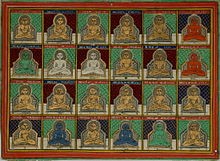
Jainism is a transtheistic religion, holding that the universe was not created, and will exist forever. It is believed to be independent, having no creator, governor, judge, or destroyer. In this, it is unlike the Abrahamic religions, but similar to Buddhism. However, Jainism believes in the world of heavenly and hell beings who are born, die and reborn like earthly beings. Jain texts maintain that souls who live happily in the body of a god do so because of their positive karma. It is further stated that they possess a more transcendent knowledge about material things and can anticipate events in the human realms. However, once their past karmic merit is exhausted, it is explained that their souls are reborn again as humans, animals or other beings. In Jainism, perfect souls with a body are called arihant (victors) and perfect souls without a body are called Siddhas (liberated souls).
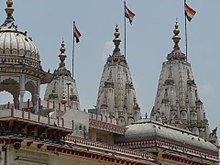
According to Jainism, purification of soul and liberation can be achieved through the path of four jewels: Samyak darsana (Correct View), meaning faith, acceptance of the truth of soul (jiva); Samyak gyana (Correct Knowledge), meaning undoubting knowledge of the tattvas; and Samyak charitra (Correct Conduct), meaning behavior consistent with the Five vows. Jain texts often add samyak tap (Correct Asceticism) as a fourth jewel, emphasizing belief in ascetic practices as the means to liberation (moksha). The four jewels are called moksha marg (the path of liberation).
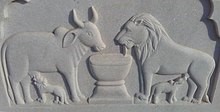
The principle of ahimsa (non-violence or non-injury) is a fundamental tenet of Jainism. It holds that one must abandon all violent activity and that without such a commitment to non-violence all religious behavior is worthless. In Jain theology, it does not matter how correct or defensible the violence may be, one must not kill or harm any being, and non-violence is the highest religious duty. Jain texts such as Acaranga Sutra and Tattvarthasutra state that one must renounce all killing of living beings, whether tiny or large, movable or immovable. Its theology teaches that one must neither kill another living being, nor cause another to kill, nor consent to any killing directly or indirectly. Furthermore, Jainism emphasizes non-violence against all beings not only in action but also in speech and in thought. It states that instead of hate or violence against anyone, "all living creatures must help each other".Jains believe that violence negatively affects and destroys one's soul, particularly when the violence is done with intent, hate or carelessness, or when one indirectly causes or consents to the killing of a human or non-human living being.
The doctrine exists in Hinduism and Buddhism, but is most highly developed in Jainism. The theological basis of non-violence as the highest religious duty has been interpreted by some Jain scholars not to "be driven by merit from giving or compassion to other creatures, nor a duty to rescue all creatures", but resulting from "continual self-discipline", a cleansing of the soul that leads to one's own spiritual development which ultimately affects one's salvation and release from rebirths. Jains believe that causing injury to any being in any form creates bad karma which affects one's rebirth, future well being and causes suffering.
Late medieval Jain scholars re-examined the Ahimsa doctrine when faced with external threat or violence. For example, they justified violence by monks to protect nuns. According to Dundas, the Jain scholar Jinadattasuri wrote during a time of Muslim destruction of temples and persecution that "anybody engaged in a religious activity who was forced to fight and kill somebody would not lose any spiritual merit but instead attain deliverance".However, examples in Jain texts that condone fighting and killing under certain circumstances are relatively rare
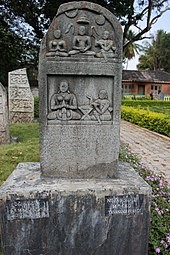
Jainism teaches five ethical duties, which it calls five vows. These are called anuvratas (small vows) for Jain laypersons, and mahavratas (great vows) for Jain mendicants. For both, its moral precepts preface that the Jain has access to a guru (teacher, counsellor), deva (Jina, god), doctrine, and that the individual is free from five offences: doubts about the faith, indecisiveness about the truths of Jainism, sincere desire for Jain teachings, recognition of fellow Jains, and admiration for their spiritual pursuits. Such a person undertakes the following Five vows of Jainism:
1. Ahimsa,"intentional non-violence" or "noninjury":The first major vow taken by Jains is to cause no harm to other human beings, as well as all living beings (particularly animals). This is the highest ethical duty in Jainism, and it applies not only to one's actions, but demands that one be non-violent in one's speech and thoughts.
2. Satya,"truth": This vow is to always speak the truth. Neither lie, nor speak what is not true, and do not encourage others or approve anyone who speaks an untruth.
3. Asteya,"not stealing": A Jain layperson should not take anything that is not willingly given. Additionally, a Jain mendicant should ask for permission to take it if something is being given.
4. Brahmacharya,"celibacy": Abstinence from sex and sensual pleasures is prescribed for Jain monks and nuns. For laypersons, the vow means chastity, faithfulness to one's partner.
5. Aparigraha,"non-possessiveness": This includes non-attachment to material and psychological possessions, avoiding craving and greed. Jain monks and nuns completely renounce property and social relations, own nothing and are attached to no one.
Jainism prescribes seven supplementary vows, including three guna vratas (merit vows) and four siksa vratas. The Sallekhana (or Santhara) vow is a "religious death" ritual observed at the end of life, historically by Jain monks and nuns, but rare in the modern age. In this vow, there is voluntary and gradual reduction of food and liquid intake to end one's life by choice and with dispassion, This is believed to reduce negative karma that affects a soul's future rebirths.
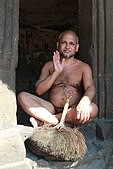
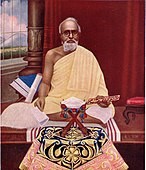

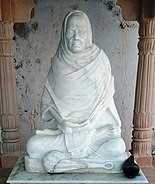
Of the major Indian religions, Jainism has had the strongest ascetic tradition. Ascetic life may include nakedness, symbolizing non-possession even of clothes, fasting, body mortification, and penance, to burn away past karma and stop producing new karma, both of which are believed essential for reaching siddha and moksha ("liberation from rebirths" and "salvation"). Jain texts like Tattvartha Sutra and Uttaradhyayana Sutra discuss austerities in detail. Six outer and six inner practices are oft-repeated in later Jain texts. Outer austerities include complete fasting, eating limited amounts, eating restricted items, abstaining from tasty foods, mortifying the flesh, and guarding the flesh (avoiding anything that is a source of temptation). Inner austerities include expiation, confession, respecting and assisting mendicants, studying, meditation, and ignoring bodily wants in order to abandon the body. Lists of internal and external austerities vary with the text and tradition. Asceticism is viewed as a means to control desires, and to purify the jiva (soul). The tirthankaras such as the Mahavira (Vardhamana) set an example by performing severe austerities for twelve years Monastic organization, sangh, has a four-fold order consisting of sadhu (male ascetics, muni), sadhvi (female ascetics, aryika), sravaka (laymen), and sravika (laywomen). The latter two support the ascetics and their monastic organizations called gacch or samuday, in autonomous regional Jain congregations. Jain monastic rules have encouraged the use of mouth cover, as well as the Dandasan a long stick with woolen threads to gently remove ants and insects that may come in their path.
The practice of non-violence towards all living beings has led to Jain culture being vegetarian. Devout Jains practice lacto-vegetarianism, meaning that they eat no eggs, but accept dairy products if there is no violence against animals during their production. Veganism is encouraged if there are concerns about animal welfare. Jain monks, nuns and some followers avoid root vegetables such as potatoes, onions, and garlic because tiny organisms are injured when the plant is pulled up, and because a bulb or tuber's ability to sprout is seen as characteristic of a higher living being. [c] Jain monks and advanced laypeople avoid eating after sunset, observing a vow of ratri-bhojana-tyaga-vrata. Monks observe a stricter vow by eating only once a day.
Jains fast particularly during festivals. This practice is called upavasa, tapasya or vrata, and may be practiced according to one's ability. Digambaras fast for Dasa-laksana-parvan, eating only one or two meals per day, drinking only boiled water for ten days, or fasting completely on the first and last days of the festival, mimicking the practices of a Jain mendicant for the period Svetambara Jains do similarly in the eight day paryusana with samvatsari-pratikramana. The practice is believed to remove karma from one's soul and provides merit (punya). A "one day" fast lasts about 36 hours, starting at sunset before the day of the fast and ending 48 minutes after sunrise the day after. Among laypeople, fasting is more commonly observed by women, as it shows her piety and religious purity, gains merit earning and helps ensure future well-being for her family. Some religious fasts are observed in a social and supportive female group. Long fasts are celebrated by friends and families with special ceremonies.

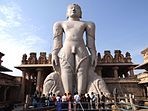
Jainism considers meditation (dhyana) a necessary practice, but its goals are very different from those in Buddhism and Hinduism. In Jainism, meditation is concerned more with stopping karmic attachments and activity, not as a means to transformational insights or self-realization in other Indian religions. According to Padmanabh Jaini, Samayika is a practice of "brief periods in meditation" in Jainism that is a part of siksavrata (ritual restraint). The goal of Samayika is to achieve equanimity, and it is the second siksavrata.[d] The samayika ritual is practiced at least three times a day by mendicants, while a layperson includes it with other ritual practices such as Puja in a Jain temple and doing charity work. According to Johnson, as well as Jaini, samayika connotes more than meditation, and for a Jain householder is the voluntary ritual practice of "assuming temporary ascetic status".
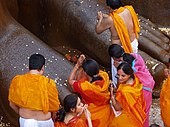
There are many rituals in Jainism's various sects. According to Dundas, the ritualistic lay path among Svetambara Jains is "heavily imbued with ascetic values", where the rituals either revere or celebrate the ascetic life of Tirthankaras, or progressively approach the psychological and physical life of an ascetic. The ultimate ritual is sallekhana, a religious death through ascetic abandonment of food and drinks. The Digambara Jains follow the same theme, but the life cycle and religious rituals are closer to a Hindu liturgy. The overlap is mainly in the life cycle (rites-of-passage) rituals, and likely developed because Jain and Hindu societies overlapped, and rituals were viewed as necessary and secular.
Jains ritually worship numerous deities, especially the Jinas. In Jainism a Jina as deva is not an avatar (incarnation), but the highest state of omniscience that an ascetic tirthankara achieved. Out of the 24 Tirthankaras, Jains predominantly worship four: Mahavira, Parshvanatha, Neminatha and Rishabhanatha. Among the non-tirthankara saints, devotional worship is common for Bahubali among the Digambaras. The Panch Kalyanaka rituals remember the five life events of the tirthankaras, including the Panch Kalyanaka Pratishtha Mahotsava, Panch Kalyanaka Puja and Snatrapuja.

The basic ritual is darsana (seeing) of deva, which includes Jina, or other yaksas, gods and goddesses such as Brahmadeva, 52 Viras, Padmavati, Ambika and 16 Vidyadevis (including Sarasvati and Lakshmi). Terapanthi Digambaras limit their ritual worship to Tirthankaras. The worship ritual is called devapuja, and is found in all Jain sub-traditions. Typically, the Jain layperson enters the temple inner sanctum in simple clothing and bare feet with a plate filled with offerings, bows down, says the namaskar, completes his or her litany and prayers, sometimes is assisted by the temple priest, leaves the offerings and then departs.
Jain practices include performing abhisheka (ceremonial bath) of the images. Some Jain sects employ a pujari (also called upadhye), who may be a Hindu, to perform priestly duties at the temple. More elaborate worship includes offerings such as rice, fresh and dry fruits, flowers, coconut, sweets, and money. Some may light up a lamp with camphor and make auspicious marks with sandalwood paste. Devotees also recite Jain texts, particularly the life stories of the tirthankaras.
Traditional Jains, like Buddhists and Hindus, believe in the efficacy of mantras and that certain sounds and words are inherently auspicious, powerful and spiritual. The most famous of the mantras, broadly accepted in various sects of Jainism, is the "five homage" (panca namaskara) mantra which is believed to be eternal and existent since the first tirthankara's time. Medieval worship practices included making tantric diagrams of the Rishi-mandala including the tirthankaras. The Jain tantric traditions use mantra and rituals that are believed to accrue merit for rebirth realms.
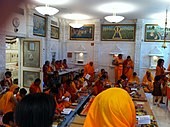
The most important annual Jain festival is called the Paryushana by Svetambaras and Dasa lakshana parva by the Digambaras. It is celebrated from the 12th day of the waning moon in the traditional lunisolar month of Bhadrapada in the Indian calendar. This typically falls in August or September of the Gregorian calendar. It lasts eight days for Svetambaras, and ten days among the Digambaras. It is a time when lay people fast and pray. The five vows are emphasized during this time. Svetambaras recite the Kalpasutras, while Digambaras read their own texts. The festival is an occasion where Jains make active effort to stop cruelty towards other life forms, freeing animals in captivity and preventing the slaughter of animals.
The last day involves a focused prayer and meditation session known as Samvatsari. Jains consider this a day of atonement, granting forgiveness to others, seeking forgiveness from all living beings, physically or mentally asking for forgiveness and resolving to treat everyone in the world as friends. Forgiveness is asked by saying "Micchami Dukkadam" or "Khamat khamna" to others. This means, "If I have offended you in any way, knowingly or unknowingly, in thought, word or action, then I seek your forgiveness." The literal meaning of Paryushana is "abiding" or "coming together".
Mahavir Janma Kalyanak celebrates the birth of Mahavira. It is celebrated on the 13th day of the lunisolar month of Chaitra in the traditional Indian calendar. This typically falls in March or April of the Gregorian calendar. The festivities include visiting Jain temples, pilgrimages to shrines, reading Jain texts and processions of Mahavira by the community. At his legendary birthplace of Kundagrama in Bihar, north of Patna, special events are held by Jains. The next day of Dipawali is observed by Jains as the anniversary of Mahavira 's attainment of moksha. The Hindu festival of Diwali is also celebrated on the same date (Kartika Amavasya). Jain temples, homes, offices, and shops are decorated with lights and diyas (small oil lamps). The lights are symbolic of knowledge or removal of ignorance. Sweets are often distributed. On Diwali morning, Nirvan Ladoo is offered after praying to Mahavira in all Jain temples across the world. The Jain new year starts right after Diwali. Some other festivals celebrated by Jains are Akshaya Tritiya and Raksha Bandhan, similar to those in the Hindu communities.
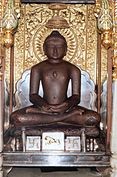
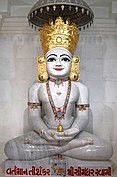
The Jain community is divided into two major denominations, Digambara and Svetambara. Monks of the Digambara (sky-clad) tradition do not wear clothes. Female monastics of the Digambara sect wear unstitched plain white sarees and are referred to as Aryikas. Svetambara (white-clad) monastics, on the other hand, wear seamless white clothes.
During Chandragupta Maurya's reign, Jain tradition states that Acharya Bhadrabahu predicted a twelve-year-long famine and moved to Karnataka with his disciples. Sthulabhadra, a pupil of Acharya Bhadrabahu, is believed to have stayed in Magadha. Later, as stated in tradition, when followers of Acharya Bhadrabahu returned, they found those who had remained at Magadha had started wearing white clothes, which was unacceptable to the others who remained naked. This is how Jains believe the Digambara and Svetambara schism began, with the former being naked while the latter wore white clothes. Digambara saw this as being opposed to the Jain tenet of aparigraha which, according to them, required not even possession of clothes, i.e. complete nudity. In the 5th-century CE, the Council of Valabhi was organized by Svetambara, which Digambara did not attend. At the council, the Svetambara adopted the texts they had preserved as canonical scriptures, which Digambara has ever since rejected. This council is believed to have solidified the historic schism between these two major traditions of Jainism. The earliest record of Digambara beliefs is contained in the Prakrit Suttapahuda of Kundakunda.
Digambaras and Svetambara differ in their practices and dress code, interpretations of teachings, and on Jain history especially concerning the tirthankaras. Their monasticism rules differ, as does their iconography. Svetambara has had more female than male mendicants, where Digambara has mostly had male monks and considers males closest to the soul's liberation. The Svetambara believe that women can also achieve liberation through asceticism and state that the 19th Tirthankara Mallinatha was female, which Digambara rejects.
Excavations at Mathura revealed Jain statues from the time of the Kushan Empire (c. 1st century CE). Tirthankara represented without clothes, and monks with cloth wrapped around the left arm, are identified as the Ardhaphalaka (half-clothed) mentioned in texts. The Yapaniyas, believed to have originated from the Ardhaphalaka, followed Digambara nudity along with several Svetambara beliefs. In the modern era, according to Flugel, new Jain religious movements that are a "primarily devotional form of Jainism" have developed which resemble "Jain Mahayana" style devotionalism.
A Jain temple, a Derasar or Basadi, is a place of worship. Temples contain tirthankara images, some fixed, others moveable. These are stationed in the inner sanctum, one of the two sacred zones, the other being the main hall. One of the images is marked as the moolnayak (primary deity). A manastambha (column of honor) is a pillar that is often constructed in front of Jain temples. Temple construction is considered a meritorious act.
Ancient Jain monuments include the Udaigiri Hills near Bhelsa (Vidisha) in Madhya Pradesh, the Ellora in Maharashtra, the Palitana temples in Gujarat, and the Jain temples at Dilwara Temples near Mount Abu, Rajasthan. Chaumukha temple in Ranakpur is considered one of the most beautiful Jain temples and is famous for its detailed carvings. According to Jain texts, Shikharji is the place where twenty of the twenty-four Jain Tirthankaras along with many other monks attained moksha (died without being reborn, with their soul in Siddhashila). The Shikharji site in northeastern Jharkhand is therefore a revered pilgrimage site. [j] The Palitana temples are the holiest shrine for the Svetambara Murtipujaka sect. Along with Shikharji the two sites are considered the holiest of all pilgrimage sites by the Jain community. The Jain complex, Khajuraho and Jain Narayana temple are part of a UNESCO World Heritage Site. Shravanabelagola, Saavira Kambada Basadi or 1000 pillars and Brahma Jinalaya are important Jain centers in Karnataka. In and around Madurai, there are 26 caves, 200 stone beds, 60 inscriptions, and over 100 sculptures.
The 2nd-1st century BCE Udayagiri and Khandagiri Caves are rich with carvings of tirthanakars and deities with inscriptions including the Elephant Cave inscription. Jain cave temples at Badami, Mangi-Tungi and the Ellora Caves are considered important. The Sittanavasal Cave temple is a fine example of Jain art with an early cave shelter, and a medieval rock-cut temple with excellent fresco paintings comparable to Ajantha. Inside are seventeen stone beds with 2nd century BCE Tamil-Brahmi inscriptions. The 8th century Kazhugumalai temple marks the revival of Jainism in South India.

Outside contemporary India, Jain communities built temples in locations such as Nagarparkar, Sindh (Pakistan). However, according to a UNESCO tentative world heritage site application, Nagarparkar was not a "major religious centre or a place of pilgrimage" for Jainism, but it was once an important cultural landscape before "the last remaining Jain community left the area in 1947 at Partition".
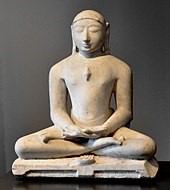
Jain sculptures usually depict one of the twenty-four tirthankaras; Parshvanatha, Rishabhanatha and Mahavira are among the more popular, often seated in lotus position or kayotsarga, along with Arihant, Bahubali, and protector deities like Ambika. Quadruple images are also popular. Tirthankar idols look similar, differentiated by their individual symbol, except for Parshvanatha whose head is crowned by a snake. Digambara images are naked without any beautification, whereas Svetambara depictions are clothed and ornamented.
A monolithic, 18-metre (59-foot) statue of Bahubali, Gommateshvara, built in 981 CE by the Ganga minister and commander Chavundaraya, is situated on a hilltop in Shravanabelagola in Karnataka. This statue was voted first in the SMS poll Seven Wonders of India conducted by The Times of India.[290] The 33 m (108 ft) tall Statue of Ahi?sa (depicting Rishabhanatha) was erected in the Nashik district in 2015. Idols are often made in Ashtadhatu (literally "eight metals"), namely Akota Bronze, brass, gold, silver, stone monoliths, rock cut, and precious stones.

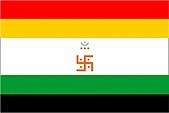
Jain icons and arts incorporate symbols such as the swastika, Om, and the Ashtamangala. In Jainism, Om is a condensed reference to the initials "A-A-A-U-M" of the five parameshthis: "Arihant, Ashiri, Acharya, Upajjhaya, Munior the five lines of the Namokara Mantra. The Ashtamangala is a set of eight auspicious symbols: in the Digambara tradition, these are Chatra, Dhvaja, Kalasha, Fly-whisk, Mirror, Chair, Hand fan and Vessel. In the Svetambar tradition, they are Swastika, Srivatsa, Nandavarta, Vardhmanaka (food vessel), Bhadrasana (seat), Kalasha (pot), Darpan (mirror) and pair of fish.
The hand with a wheel on the palm symbolizes ahimsa. The wheel represents the dharmachakra, which stands for the resolve to halt the sa?sara (wandering) through the relentless pursuit of ahimsa. The five colours of the Jain flag represent the Panca-Paramesthi and the five vows. The swastika's four arms symbolise the four realms in which rebirth occurs according to Jainism: humans, heavenly beings, hellish beings and non-humans. The three dots on the top represent the three jewels mentioned in ancient texts: correct faith, correct understanding and correct conduct, believed to lead to spiritual perfection.
In 1974, on the 2500th anniversary of the nirvana of Mahavira, the Jain community chose a single combined image for Jainism. It depicts the three lokas, heaven, the human world and hell. The semi-circular topmost portion symbolizes Siddhashila, a zone beyond the three realms. The Jain swastika and the symbol of Ahimsa are included, with the Jain mantra Parasparopagraho Jivanam[304] from sutra 5.21 of Umaswati's Tattvarthasutra, meaning "souls render service to one another".
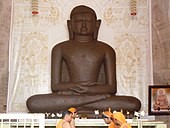
Chaumukha Sculpture with Four Jinas (Rishabhanatha (Adinatha), Parshvanatha, Neminatha, and Mahavira), LACMA, 6th century
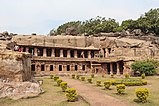
Udayagiri and Khandagiri Caves built by King Kharavela of Mahameghavahana dynasty in 2nd century BCE
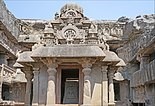
The Indra Sabha cave at the Ellora Caves, are co-located with Hindu and Buddhist monuments.
Jainism is an ancient Indian religion of obscure origins. Jains claim it to be eternal, and consider the first tirthankara Rishabhanatha as the reinforcer of Jain Dharma in the current time cycle. Scholars have conjectured that images such as those of the bull in Indus Valley Civilization seal are related to Jainism. It is one of the Srama?a traditions of ancient India, those that rejected the Vedas, and according to the philosopher Sarvepalli Radhakrishnan, it existed before them.
The historicity of first twenty two Tirthankars is not traced yet. The 23rd tirthankar, Parshvanatha, was a historical being, possibly of the eighth century BCE. Mahavira is considered a contemporary of the Buddha, in around the 6th century BCE. The interaction between the two religions began with the Buddha; later, they competed for followers and the merchant trade networks that sustained them. Buddhist and Jain texts sometimes have the same or similar titles but present different doctrines.
Jains consider the kings Bimbisara (c. 558-491 BCE), Ajatashatru (c. 492-460 BCE), and Udayin (c. 460-440 BCE) of the Haryanka dynasty as patrons of Jainism. Jain tradition states that Chandragupta Maurya (322-298 BCE), the founder of the Mauryan Empire and grandfather of Ashoka, became a monk and disciple of Jain ascetic Bhadrabahu in the later part of his life. Jain texts state that he died intentionally at Shravanabelagola by fasting. Versions of Chandragupta's story appear in Buddhist, Jain, and Hindu texts.
The 3rd century BCE emperor Ashoka, in his pillar edicts, mentions the Niganthas (Jains). Tirthankara statues date back to the second century BCE. Archeological evidence suggests that Mathura was an important Jain center from the 2nd century BCE onwards. Inscriptions from as early as the 1st century CE already show the schism between Digambara and Svetambara. There is inscriptional evidence for the presence of Jain monks in south India by the second or first centuries BCE, and archaeological evidence of Jain monks in Saurashtra in Gujarat by the second century CE. Royal patronage has been a key factor in the growth and decline of Jainism. In the second half of the 1st century CE, Hindu kings of the Rashtrakuta dynasty sponsored major Jain cave temples. King Harshavardhana of the 7th century championed Jainism, Buddhism and all traditions of Hinduism. The Pallava King Mahendravarman I (600-630 CE) converted from Jainism to Shaivism. His work Mattavilasa Prahasana ridicules certain Shaiva sects and the Buddhists and expresses contempt for Jain ascetics. The Yadava dynasty built many temples at the Ellora Caves between 700 and 1000 CE. King Ama of the 8th century converted to Jainism, and the Jain pilgrimage tradition was well established in his era. Mularaja (10th century CE), the founder of the Chalukya dynasty, constructed a Jain temple, even though he was not a Jain. During the 11th century, Basava, a minister to the Jain Kalachuri king Bijjala, converted many Jains to the Lingayat Shaivite sect. The Lingayats destroyed Jain temples and adapted them to their use. The Hoysala King Vishnuvardhana (c. 1108-1152 CE) became a Vaishnavite under the influence of Ramanuja, and Vaishnavism then grew rapidly in what is now Karnataka.
Followers of Jainism are called "Jains", a word derived from the Sanskrit jina (victor), which means an omniscient person who teaches the path of salvation. The majority of Jains currently reside in India. With four to five million followers worldwide, Jainism is small compared to major world religions. Jains form 0.37% of India's population, mostly in the states of Maharashtra (1.4 million in 2011, 31.46% of Indian Jains), Rajasthan (13.97%), Gujarat (13.02%) and Madhya Pradesh (12.74%). Karnataka (9.89%), Uttar Pradesh (4.79%), Delhi (3.73%) and Tamil Nadu (2.01%) also have significant Jain populations. Outside India, Jain communities can be found in Europe, the United Kingdom, the United States, Canada, Australia and Kenya. Jainism is also spreading rapidly in Japan, where there are more than 5,000 families who have converted to Jainism. According to the National Family and Health Survey (NFHS-4) conducted in 2015-16, Jains form the wealthiest community in India. Jains have the highest literacy rate (87%) in India, in the 7-years to oldest age group, according to its 2011 census, and the most college graduates. Excluding the retired, Jain literacy in India exceeded 97%. The female to male sex ratio in Jains is 940, while in the 0-6 year age was second lowest for Jains (870 girls per 1,000 boys), higher than Sikhs in India. Jain males have the highest work participation rates in India, while Jain females have the lowest. Jainism has been praised for some of its practices and beliefs. The leader of the campaign for Indian independence, Mahatma Gandhi, greatly influenced by Jainism, said: No religion in the World has explained the principle of Ahimsa so deeply and systematically as is discussed with its applicability in every human life in Jainism. As and when the benevolent principle of Ahimsa or non-violence will be ascribed for practice by the people of the world to achieve their end of life in this world and beyond, Jainism is sure to have the uppermost status and Mahavira is sure to be respected as the greatest authority on Ahimsa.
Chandanaji became the first Jain woman to receive the title of Acharya in 1987.